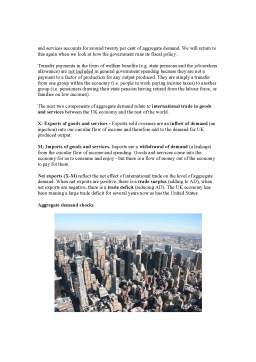Extras din proiect
Aggregate supply and aggregate demand
Aggregate Supply
Having looked at the components of aggregate demand, we now turn to the supply-side of the economy. Aggregate supply tells us something about whether producers across the economy can supply us with the goods and services that we need.
A definition of aggregate supply
Aggregate supply (AS) measures the volume of goods and services produced within the economy at a given price level. In simple terms, aggregate supply represents the ability of an economy to produce goods and services either in the short-term or in the long-term. It tells us the quantity of real GDP that will be supplied at various price levels. The nature of this relationship will differ between the long run and the short run
- In the long run, the aggregate-supply curve is assumed to be vertical
- In the short run, the aggregate-supply curve is assumed to be upward sloping
Short run aggregate supply (SRAS) shows total planned output when prices in the economy can change but the prices and productivity of all factor inputs e.g. wage rates and the state of technology are assumed to be held constant.
Long run aggregate supply (LRAS): LRAS shows total planned output when both prices and average wage rates can change – it is a measure of a country’s potential output and the concept is linked strongly to that of the production possibility frontier
The short run aggregate supply curve
A change in the price level (for example brought about by a shift in AD) results in a movement along the short run aggregate supply curve. The slope of SRAS curve depends on the degree of spare (under-utilised) capacity within the economy.
- Negative output gap: At low levels of real national income where actual GDP < potential GDP, firms have a large amount of spare capacity and can expand their output without paying their workers overtime. The SRAS curve is therefore drawn as elastic
- Positive output gap: As national output expands and the economy heads towards full capacity, so “supply bottlenecks and shortages” may start to appear in some sectors and industries. Workers receive the same wage rate but require payment of overtime and bonuses to work longer hours and increase GDP – SRAS is becoming more inelastic
- Diminishing returns? As national output expands, older less productive machinery may be used and less efficient workers hired. This means that while wage rates remain constant, unit costs of production may rise and thus the SRAS slopes upwards
- Full-capacity output at LRAS. Eventually the economy cannot increase the volume of output further in the short-term no matter what bonus or overtime payments on offer, at this point SRAS is perfectly inelastic – the economy has reached full-capacity (the LRAS curve)
Shifts in short run aggregate supply (SRAS)
Shifts in the SRAS curve can be caused by the following factors
- Changes in unit labour costs: Unit labour costs are defined as wage costs adjusted for the level of productivity. For example a rise in unit labour costs might be brought about by firms agreeing to pay higher wages or a fall in the level of worker productivity. If unit wage costs rise, this will eventually feed through into higher prices (this is known as an example of “cost-push inflation”)
- Commodity prices: Changes to raw material costs and other components e.g. the world price of oil, copper, aluminium and other inputs in many production processes will affect a firm’s costs. These costs might be affected by a change in the exchange rate which causes fluctuations in the prices of imported products. A fall (depreciation) in the exchange rate increases the costs of importing raw materials and component supplies from overseas
- Government taxation and subsidy: Changes to producer taxes and subsidies levied by the government as part of their fiscal policy have effects on the costs of nearly every producer – for example an increase in taxes designed to meet the government’s environmental objectives will cause higher costs and an inward shift in the short run aggregate supply curve. A rise in VAT on raw materials will have the same effect.
Preview document
Conținut arhivă zip
- Macroeconomics Project - Aggregate Supply and Demand.doc

















